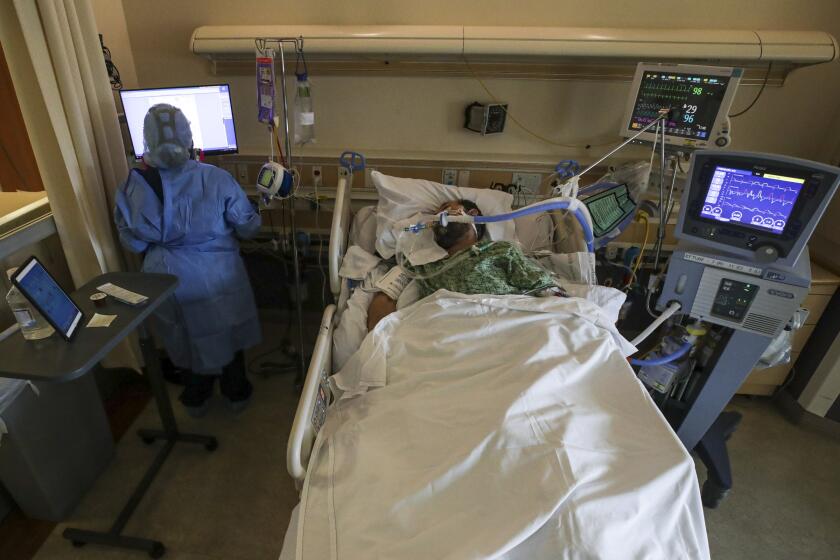Americans With HIV Estimated at 1 Million
As many as 1 million Americans are now living with HIV infections and about half are undiagnosed or untreated, the Centers for Disease Control and Prevention said here Monday.
AIDS death rates in the U.S. have declined sharply because of successful therapies. As recently as 1996, the last year before new combinations of drugs began prolonging survival, there were 38,025 AIDS deaths reported. By 2000, 15,245 people died. At the same time, however, the number of Americans becoming newly infected has remained stubbornly steady at about 40,000 each year.
As a result, the number of people living with the virus that causes the disease is now increasing by about 25,000 a year, bringing the total number of people infected to an all-time high.
Based on some random testing and statistical analyses, the CDC estimates that about a quarter of those infected do not know they have the disease, which puts them at the highest risk for spreading the illness. That proportion has declined in recent years. In 1998, about a third of those who were infected had not been diagnosed, the CDC estimates. The existence of effective therapies for AIDS has encouraged people to get tested.
Still, even when people know they are infected, about a third are not being treated, epidemiologist Patricia Fleming told the ninth annual Retrovirus Conference here.
“A major part of what we are trying to do at CDC is to get people tested,” said Dr. Harold Jaffe, director of the CDC’s National Center for HIV, Sexually Transmitted Diseases and Tuberculosis Prevention. The CDC, he noted, is starting a major new public education drive to encourage more testing.
Some people are being dissuaded from testing by continuing reports of adverse effects from antiviral therapy, said Dr. Constance Benson of the University of Colorado Health Sciences Center.
“That really resulted in people feeling that maybe they don’t want to be in therapy, so that there is no reason to be tested,” she said.
But therapy remains very effective, she added, and has kept the death rate low despite the complications associated with the drugs.
“The take-home message is that there are more people living with HIV than ever before, there are too many who are diagnosed too late, and there are an unacceptable number not receiving treatment and services,” Jaffe said.
According to the latest figures on the course of the AIDS epidemic--estimates that have been revised over the years--about 400,000 to 450,000 Americans were infected with the disease in 1984. By 1986, the number had grown to 550,000 to 650,000. By 1992, the figure was 650,000 to 900,000.
Fleming and her colleagues used data from the 25 states that have extensive HIV and AIDS reporting to estimate that the total number of Americans living with HIV increased by about 25,000 a year from 1998 to 2000, bringing the total in 2000 to between 850,000 to 950,000.
On the reasonable assumption that the growth has remained constant during the last two years, the total is now nearing 900,000 to 1 million.
In another report, CDC officials noted that when AIDS victims do die, fewer are dying from such conditions as tuberculosis and pneumocystic pneumonia, which have been considered defining characteristics of AIDS. A higher percentage are dying from liver and kidney disease, the report showed.
The shift in causes of death is probably due to several factors, said the CDC’s Dr. Mitchell I. Wolfe. Some of the drugs used to treat HIV infections can produce kidney and liver damage, Wolfe noted, so at least some of the increase may be attributable to such complications. But because effective drug treatments mean people can live longer with AIDS than before, the average age of the population with AIDS is increasing, he said, and both kidney and liver diseases are more common in the elderly.
Wolfe and his colleagues studied causes of death in six U.S. cities--including Los Angeles--before 1996 and afterward.
The biggest drops in the causes of death came in tuberculosis and non-TB mycobacterial infections. Before 1996, TB accounted for 4.4% of AIDS deaths; afterward, it represented only 1.9%. Similarly, the proportion of deaths from non-TB mycobacterial infections fell from 14.3% to 9.2%. Pneumocystis pneumonia also declined, from 10.6% to 6.7%.
Wolfe attributed these declines to better treatments for the infections and to the stronger immune systems of patients receiving combination therapies for HIV.
Other causes of death, including non-pneumocystis pneumonia and Kaposi’s sarcoma, showed no change.
But deaths due to kidney and liver diseases jumped significantly. The proportion of deaths resulting from kidney disease rose from 8.0% to 10.3%, while that of liver disease climbed from 5.4% to 8.1%.
The proportion of deaths from wasting and non-Hodgkins lymphoma also rose during the period, for reasons that are not clear.



